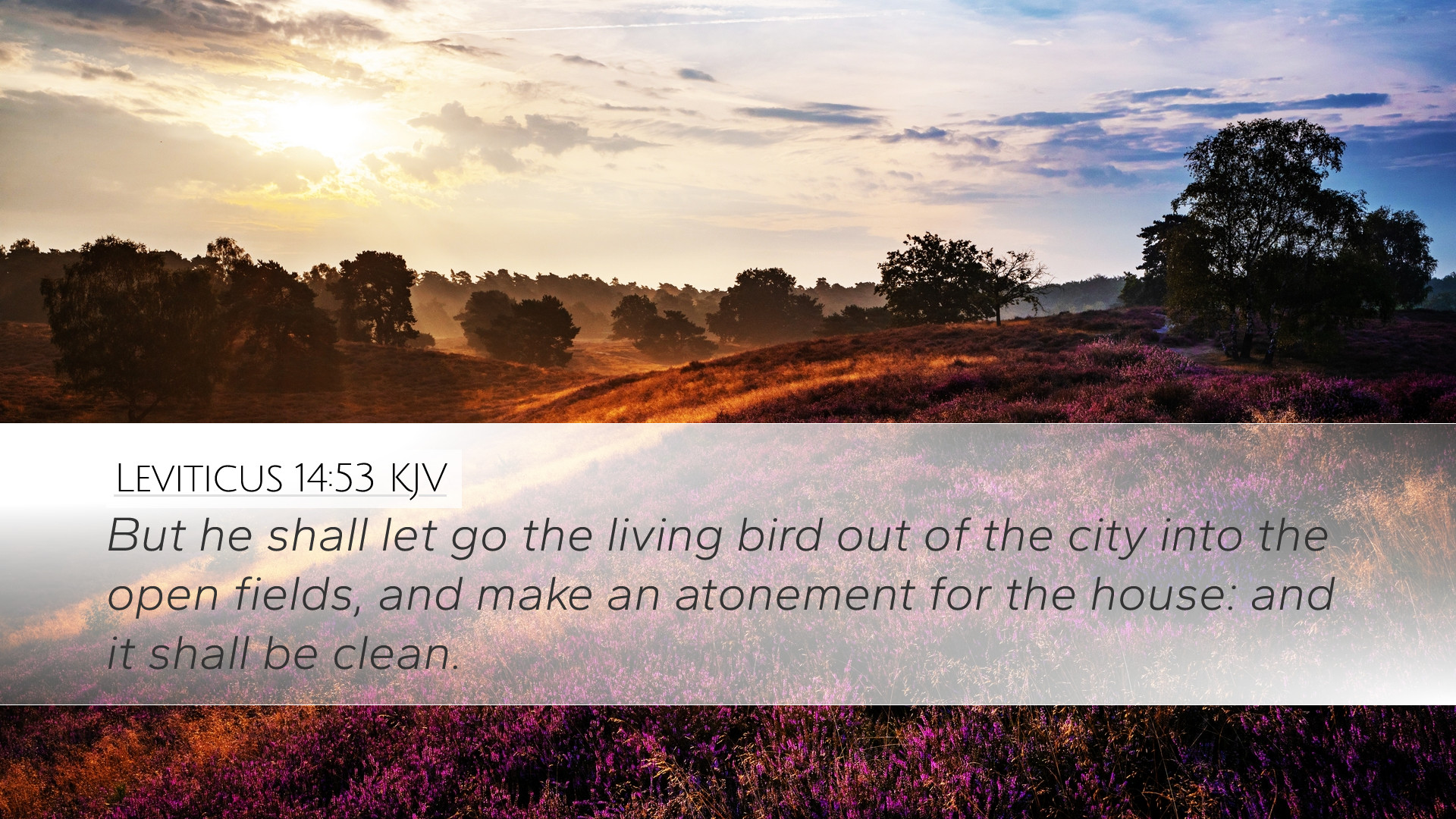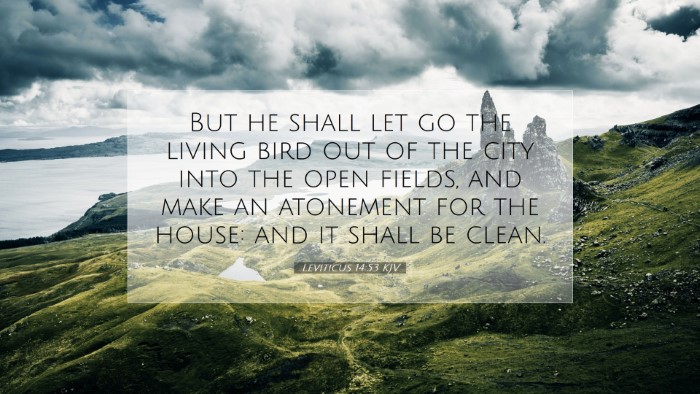Commentary on Leviticus 14:53
Verse: Leviticus 14:53 - "But he shall let go the living bird out of the city into the open fields, and the priest shall make an atonement for him, and he shall be clean." (KJV)
Introduction
The passage in Leviticus 14:53 concludes the ceremonial process of cleansing a leper or one afflicted with skin diseases, a practice laden with theological significance concerning purity, sin, and the nature of atonement. This commentary seeks to explore the layers of meaning found in this verse, drawing insights from notable public domain commentaries.
The Symbolism of the Living Bird
Matthew Henry's Commentary emphasizes the role of the living bird as a symbol of life and freedom. The act of releasing the bird into the open fields represents the liberation from the bondage of sin and disease. The bird flies away, symbolizing the departure of guilt and the restoration of the person to the community.
Albert Barnes notes that the two birds used in the ritual represent dual aspects of atonement: one bird is sacrificed ( symbolizing Christ’s atoning death), while the other, set free, illustrates the believer's release from sin. This duality encapsulates the essence of redemption, where Christ's sacrifice and subsequent victory over death grant believers new life.
Priestly Role in Atonement
Adam Clarke highlights the significant function of the priest in this ritual. The priest acts as an intermediary between God and man, facilitating the process of atonement. Through the priest’s actions, the leper is cleansed, demonstrating the need for a mediator in the process of reconciliation with God. Clarke draws a parallel to the New Testament, wherein Jesus Christ fulfills this priestly role by providing Himself as the ultimate sacrifice.
The phrase "make an atonement for him" indicates the active role of the priest in the restoration process, affirming the biblical principle that sin leads to separation from God, necessitating a means of reconciliation. The ritual thus serves as a foreshadowing of the atoning work of Christ.
The Concept of Cleansing and Restoration
This passage encapsulates the holistic view of cleansing and restoration in the Levitical law. According to Henry, the act of letting go of the living bird signifies not merely physical healing but also spiritual restoration. The declaration of being "clean" after the priest’s intervention speaks to God's desire to restore humanity fully. This is a key theological theme throughout Scripture, where God continually reaches out to redeem and restore His people.
Barnes reinforces this idea by suggesting that the act of the priest is akin to declaring judicial acquittal, highlighting God’s grace in the process of redemption. The certainty of being declared clean is a profound assurance for believers regarding their standing before God when they repent and seek forgiveness.
The Significance of Location: "Out of the City"
The instruction to release the bird "out of the city" has deep significance that can be explored through both historical and theological lenses. Clarke comments that the leper was often ostracized and removed from society, reflecting the consequences of sin, isolation, and shame. Releasing the bird outside the city symbolizes the severance of the affliction and the re-entry of a cleansed individual back into community, following the judgment of the priest.
This element of the ritual captures God's mandate for separation from filth and disease, while simultaneously marking the necessary path toward communal inclusivity for those whom He has cleansed. Attending to this detail affirms the comprehensive nature of biblical healing that encompasses both physical and social restoration.
Theological Reflections
In examining Leviticus 14:53 and its implications, several key theological reflections emerge:
- Nature of Sin: As reflected in the ritual, sin brings about separation, shame, and degradation. Effective atonement, heralded by Christ, restores one's relationship with God.
- Role of Atonement: The dual action in the symbolism of the birds encapsulates the heart of the Gospel - the need for death to grant life, pointing to Christ’s sufficient sacrifice.
- Restoration of Community: The release into “open fields” and cleansing facilitate the re-integration of individuals into the community of faith, a critical element reflecting God’s embrace of the repentant.
- The Mediating Role of Christ: This passage points profoundly to Christ as our High Priest, who mediates on behalf of humanity, allowing us to experience spiritual cleanliness through faith.
Conclusion
Leviticus 14:53 encapsulates the profound truths concerning sin, atonement, and the hope of restoration. Through the lens of public domain commentators like Matthew Henry, Albert Barnes, and Adam Clarke, we see a multidimensional understanding of this verse where the historical context, ritual significance, and theological implications converge. For pastors, students, theologians, and biblical scholars, the exploration of this passage provides meaningful insights into the nature of God’s grace, the necessity of atonement, and the call to embrace those who are cleansed and restored in Christ.


